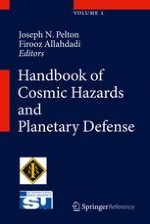Abstract
Each year humans travel through space on their own very special spacecraft called planet Earth, but that trip around the Sun is actually a very hazardous journey. Without the benefit of a space program, the human species has spent millions of years unaware of the wide range of cosmic dangers that lurk out in space. In some ways humans are playing Russian Roulette with a random set of rock and metal bullets that were first fired at this small six sextillion ton planet millions if not billions of years ago. These bullets are potentially hazardous asteroids, bolides, and meteorites. In addition there are comets that streak down toward the Sun from the Oort Cloud every few years. Perhaps an even greater danger to humans come from the nearby nuclear furnace called the Sun. Solar flares, coronal mass ejections, and continuous radiation from the Sun are warded off by the Van Allen Belts, the Earth’s geomagnetosphere, and the ozone layer that sits atop the stratosphere. During the height of the Sun’s activity that follows an 11-year cycle, the radiation and solar eruptions from the Sun hit very dangerous levels. Current research that examines the Van Allen Belts and the Earth’s magnetic shielding suggests that the protective magnetosphere shielding that protects life could be changing. And then there are other hazards from space. These risks include increasing levels of orbital debris and returning spacecraft that may contain nuclear, radiological, or chemical dangers, or even biological dangers.
The Handbook of Cosmic Hazards and Planetary Defense seeks to examine in depth the various dangers that the delicate Earth Habitat could be exposed to from outer space risks and what research needs to be done to understand in greater depth the nature of these dangers. And the editors and the authors of this book are defining “cosmic hazards” in the broadest possible terms. Thus, these hazards from outer space include comets, asteroids, and bolides that might collide with Earth. The risks to humans and modern global infrastructure include solar flares, coronal mass ejections, solar proton events, and other space weather events, as well as changes to the Earth’s protective shielding from cosmic hazards such as a lessened magnetosphere, altered Van Allen Belts, and a depleted ozone layer. This chapter also addresses orbital debris (in terms of its impact on Earth and aircraft as well as such debris possibly endangering vital infrastructure and satellite networks). This chapter even considers such hazards as cosmic radiation, antimatter events, and lethal biological agents that could come to Earth in various forms, including via returning spacecraft or astronauts.
The last part of the chapter builds on what is known about the dangers of outer space and presents the various types of activities that humans are beginning to undertake to protect life on Earth. This latter part of the handbook sets forth what types of activities can serve to protect humans and indeed all types of life-forms from mass extinctions. Such massive loss of species that include a third or more of all types of life-forms has been documented to have occurred at least five times during the Earth’s existence. These past mass extinction events have come about, on average, every 300 million years or so, over the last two billion years. These massive losses of life serve as powerful reminder that not only are there powerful hazards that can wipe out life on a massive scale, but that unless protective measures are undertaken, they could happen again with devastating effect. The rise of mass urbanization that may exceed 70 % of all people living in towns of cities by 2100 coupled with the enormous dependence on modern infrastructure such as electric power grids, telecommunications and information systems, and vast utility plants make twenty-first-century vulnerabilities to cosmic risks far greater than any previous time in human history.
The objective of this chapter is thus to present in detail what is known about the hazards of outer space and the scientific and technical nature of these threats. Further this handbook seeks to identify what steps can be undertaken to initiate a creditable planetary defense effort. It is such an effort that can unite all the people of planet Earth in a great and common undertaking.
